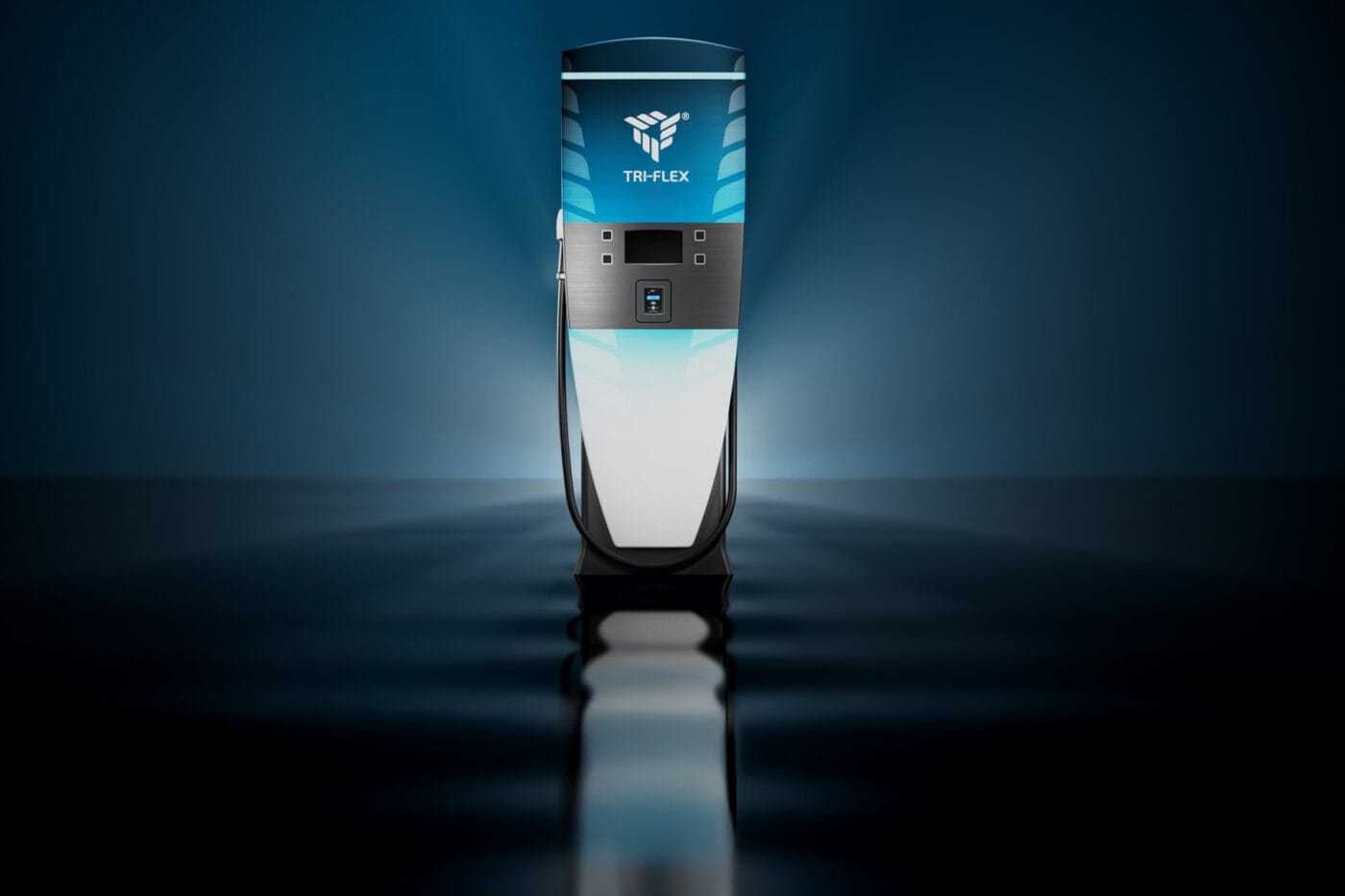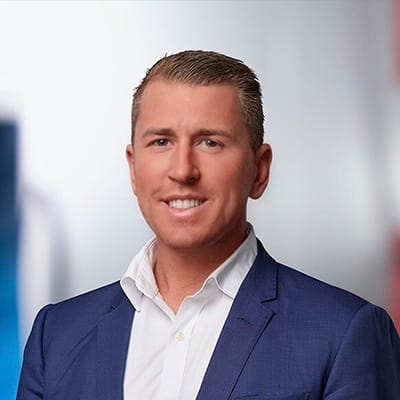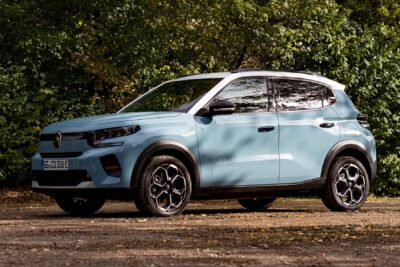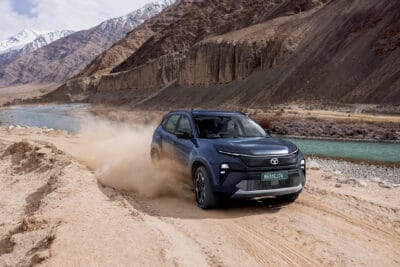
“From 400 kW to 1.6 MW” – Interview with Aaron Jones on Tritium’s Strategy
Aaron Jones, Tritium’s Chief Sales Officer, doesn’t have an easy job. Following the acquisition of the company and all its assets by Dutch firm Exicom Power Solutions, Tritium’s European strategy has undergone a fundamental shift. While the company previously focused on public HPC charging hubs for electric cars, it is now turning its attention to the growing electric truck market. Supporting this strategic pivot is the localisation of manufacturing and services in Europe.
Speaking with electrive at EVS38 in Gothenburg, Jones explained: “Our ultra-scalable platform enables charging capacities from 400 kW to 1.6 MW, which is critical for the heavy-duty vehicle sector.” With this, Tritium is targeting manufacturers such as the Volvo Group and Daimler Truck, as well as operators of large truck fleets.
The so-called Tri-Flex platform offers flexible charging solutions for a wide range of requirements – from light commercial vans to heavy-duty lorries. Jones emphasises: “Given the right demand, we can deliver megawatt-class chargers within a matter of months.” This rapid response capability, he says, gives Tritium a clear competitive edge. Tri-Flex is also designed to be scalable, featuring a central power unit connected to multiple dispensers.
Another pillar of Tritium’s strategy is localisation. While the company is not focusing on regional manufacturing per se, it is heavily investing in local support and service offerings to operate much closer to its customers, marking a significant departure from previous practices. The goal, says Jones, is to be present where the customers are. This approach not only improves supply reliability but also strengthens the trust of vehicle manufacturers and fleet operators in long-term partnerships.
How Tritium aims to position itself as a reliable provider of high-performance charging solutions for electric commercial vehicles in Europe, through a combination of technological scalability and regional presence, is revealed in our conversation at EVS38:
Following Tritium’s acquisition last year, how has your European strategy evolved, and what are your top priorities in maintaining or growing market share in this region?
It has changed the way we go about our business slightly because before, Tritium was one of the pioneers of the charging business, and we were focused on just getting hardware out there. However, supporting the infrastructure after it was installed was more of an afterthought. But we found that especially European customers rely on support from the manufacturer. So now that we have restarted the organisation with Exicom, we are leading with a services-first mindset.
What does that approach look like?
When we visit customers in Europe, we’re not just trying to sell new hardware. They already have our chargers – we’re asking how we can support them for the next decade. That was a big learning from the acquisition and from 2024: we’re effectively “married” to our customers for about 10 years. And this services-first mindset helped us to restart the relationship with our customers. And then we’ve got some exciting products to talk about with them as well. But at the moment, first steps first, we need to get back into a really good position with supportive infrastructure. And it’s been very well received.
How is this new Tritium looking to grow its market share? Who are you focusing on to grow your customer base?
The UK is our biggest market. We have more assets in the UK than in any other market. And then Europe is obviously a very large market for us as well. We have a two-pronged approach. First, partnerships – we’ll soon announce partnerships with value-added resellers, which we didn’t do much of here before. Previously, most of our business was direct with CPOs. Second, we’re focusing on fleets. Tritium has always been strong in public charging, but fleet charging is a huge growth area now.
What kind of fleets are you looking at?
So last mile logistics, middle mile, truck depots, bus depots are very prominent for us at the moment. We’ve recently made some strategic hires. So we’ve got some very smart people in that part of our business now. Across all regions, but specifically Europe, there’s going to be a very big focus on fleet charging. That’s what we’re focusing on at the moment.
Looking ahead to 2026 and beyond, where do you see Tritium’s biggest opportunities and threats in the European EV charging ecosystem—and how are you preparing for them today?
Tri-Flex will be pivotal for us with large CPOs and fleet operators. That’s where we see real opportunity. The challenge is in public charging economics. After years of excitement just getting chargers in the ground, everything now is about total cost of ownership. That’s why we focus on services – uptime, mean time between failures, and mean time to repair. Anyone who gets those right will win. Partnerships are key here too.
What kind of partnerships are we talking about?
We’re looking at distribution partnerships and service partners – traditionally called value-added resellers, but more ongoing service arrangements. There are three things needed for infrastructure: technical diagnosis, efficient parts dispatch, and technicians to physically fix chargers. We’re strong at diagnosis and dispatch – as the OEM, we should be the best at this. We now have 24/7 remote monitoring and can dispatch any part within a week, which is a big improvement.
As for technicians, we don’t need to do that ourselves unless customers want us to. Many large CPOs are seeing they can add value by managing that directly. So partnerships are about understanding where we fit best without stepping on others’ toes. The challenge is making it all work sustainably so everyone involved can run a healthy business. We need win-win partnerships across the industry to avoid failures like we’ve seen in the past.
You just launched Tri-Flex in Europe and just a few weeks ago in the US. There, you pointed out that it is MCS-ready. It that the case for Europe as well?
The system is MCS capable. For now, customers can order a 100, a 200, and a 400 kilowatt dispenser. And there’s a 640 kilowatt dispenser for some of our trucking customers.A megawatt dispenser could be ready within six months if demand comes through. But right now, there isn’t huge demand. But if we start to get orders from our customers saying they need to fit out an entire charging site, it’s an easy next step for us.
But especially truck OEMs such as Volvo Trucks and Daimler Truck keep saying there is not enough infrastructure for heavy-duty vehicles.
We’re working with all the big truck OEMs, pacing development alongside them. Sure, megawatt charging needs to be solved, and we’re ready for that. But current infrastructure is almost legacy hardware already, so we’re focused on future-proofing – for example, with IP65 rating, which we know is where the industry’s heading.
Our ultra-scalable distributed system is a leap forward. We’ll also do more technical collaboration with other parties on cabinets and power electronics central to charging solutions.
Europe is seeing intensified competition in the DC fast charging space. What is Tritium’s unique value proposition now—post-acquisition—that sets it apart from both legacy and emerging players?
One thing hasn’t changed: Tritium has always focused only on DC fast charging. We’ve never done AC and we’re not starting now. That’s why we launched Tri-Flex. It has been in development for about five years – it wasn’t just whipped up for the acquisition announcement. While competitors chase 400 kW or megawatt chargers, Tri-Flex scales beyond that – from two charging points up to 64, and from 400 kilowatts up to 1.68 megawatts, depending on site needs.
Talking to CPOs, they say big all-in-one chargers don’t make sense economically beyond four to six bays. Distributed systems are far more cost-effective at scale, and we’ve been doing that for years. Now we’re doubling down on it.
How do you compete against someone like Alpitronic?
They’ve done an outstanding job globally. It’s tough to go up against them. But many customers no longer want single-source supply – they want at least two suppliers in case one goes under. So our strategy might be to fight for position number two, and that’s not a bad place to be.
Post-takeover, what changes have you made—or resisted—to preserve Tritium’s identity, agility, and innovation culture, particularly in the European business unit?
We’re very passionate, but we went bankrupt for a reason. We have to be able to look at the mirror and say, okay, we did something wrong. We are very focused on creating a new company. The brand might be there, and the name might be there. But we don’t want to repeat past mistakes. So we have taken time to say, okay, what does a successful Tritium look like in the future? Where is the market going? Because we do believe the market’s probably going to consolidate a little bit further.
And a lot of that is such a cliche, but we do believe that being more customer-centric is the right approach. Every decision is made thinking: how will this impact the customer or their customer? That drives better decisions, and it’s something Exicom has really brought to the table.
Has the ownership change influenced Tritium’s R&D or product development cycles, particularly in terms of adapting to European regulations and customer preferences?
We are a fairly integrated organisation. Anant, the CEO, would call himself an active investor. He takes a lot of interest in what’s happening in the company. But at the same time, he set up Tritium as an independent firm. The R&D teams remain relatively separate. Exicom is learning from some of our work for their products, but their biggest support has been supply chain. As we restarted the company, we’ve had to re-engage all our suppliers and set up new supply agreements. Now, Exicom’s supply chain team became ours, negotiating new supplier agreements to better serve customers.
How is Tritium responding to the push in Europe for localised manufacturing and supply chains?
This is not a new challenge. Tritium was designing and manufacturing out of Australia. We’re probably more of a global company now. So we do R&D out of Australia, manufacturing out of the US, and our major support hubs out of the UK and Europe. That is our biggest market. But the challenge of being a foreign player in Europe, as I said, is not new challenge. But we’re not going to just set up a manufacturing facility in Europe just to appease a couple of customers. If the economics stack up over time, that’s when those decisions are made. But at the moment, we are set up the way we’re set up from there.
To be successful globally, you need to be global but act local. And so we need to make sure that if we’re going to operate in Sweden or in Germany, we have people in those regions to fully understand exactly what’s going on there. So that’s something we’ve always done very, very well – be as local as possible but understand we’re operating on a global scale.
Can Tritium go bankrupt again?
I don’t believe so. If it did, shame on us for not learning our lessons. But right now, Tritium’s in a great spot: we don’t need to raise capital or worry about debt, so financially we’re solid.
With Exicom, this isn’t just a quick flip like private equity does. They’re in it for the long haul – they’ve been around 30 years, and this is part of their global growth. In the US and Europe, it’ll be Tritium products only, and it’s all about building long-term, sustainable success together.





0 Comments